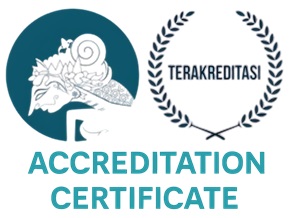Analisis Pengaruh Variasi Parameter Pemotongan Terhadap Kekasaran Permukaan Pada Proses Bubut Menggunakan Metode Taguchi
Abstract
This study aims to analyze the effect of cutting parameter variations on surface roughness in the turning process of AISI 1045 steel using the Taguchi method. The cutting parameters varied include spindle speed (rpm), feed rate (mm/rev), and depth of cut (mm). Experiments were carried out using a conventional lathe with a carbide insert (DCMT 070204 – PM 4335) and an orthogonal array design L9(3³). The analysis was conducted using the signal-to-noise (S/N) ratio with the smaller is better criterion and analysis of variance (ANOVA) to evaluate the contribution of each factor to surface roughness. The results show that the feed rate had the most significant effect, contributing 65.69% (F-value = 9.80; P-value = 0.093), followed by spindle speed at 22.04% (F-value = 3.29; P-value = 0.233), and depth of cut at 5.57% (F-value = 0.83; P-value = 0.546). The optimal parameter combination that yielded the lowest surface roughness consisted of a spindle speed of 900 rpm, a feed rate of 0.0803 mm/rev, and a depth of cut of 0.2 mm. These findings confirm the effectiveness of the Taguchi method in identifying dominant parameters with a minimal number of experimental runs.
Downloads
Copyright (c) 2025 Deni Tri Arga, Yeny Pusvyta, Arie Yudha Budiman

This work is licensed under a Creative Commons Attribution-ShareAlike 4.0 International License.











